The U.S. Amateur stroke play playoff: survive and thrive
8/12/2020 | by AmateurGolf.com Staff
see also: U.S. Amateur, a USGA Championship, Merion Golf Club - East Course
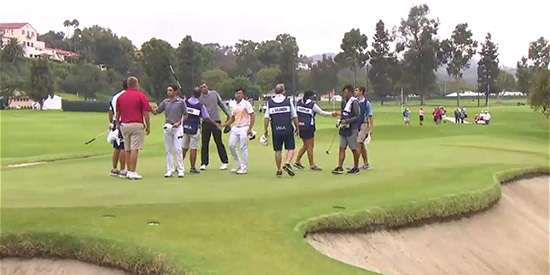
David Tenneson looks at the recent history of one of the most exciting parts of U.S. Am week, and how it can propel its survivors
In 1979, the USGA changed the format for their oldest championship to be a mix of stroke play and match play. Since that time there have only been two occasions (1985 and 2000) where the stroke play stage of the event ended with a clean cutline of exactly 64 golfers to move on to match play. All other years there has been some kind of tie around that 64th position necessitating a playoff to bridge the two stages, and this year is no exception.
18 golfers played off for the final 3 match play spots on Wednesday morning. Cameron Sisk, who had a heroic comeback with a 66 just to get into the playoff after opening with 79, birdied the 10th hole at Bandon Dunes, as did Evan Katz. Three players were eliminated with bogeys, and the other 13 went to the 11th hole to play for the final match play spot. Aaron Du birdied the difficult par 4 to claim the 64th and final spot into match play.
How have playoff survivors fared in the championship?
Once the field of 64 is finally set, the attention immediately turns to the first round of match play – the Round of 64. An interesting question is: does going through a (potentially marathon) playoff affect the chances of a player winning his match later that day?
Using the same dataset from 2000-2019, below are the Round of 64 results for playoff survivors as well as results for the same seeds in years they were not filled by playoff survivors.
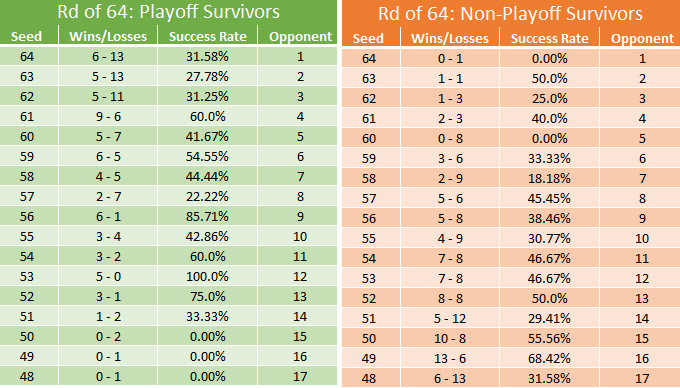
Using these two tables, we’re able to get a sense of how playoff survivors tend to perform by comparing how successful a certain seed is when filled by a playoff survivor versus a player not subject to the playoff. Focusing on seeds 52-61 where there are more than a few instances of each to compare, we see that generally speaking the playoff survivors perform better than their counterparts in the Round of 64.
Perhaps this increased success is due to the fact the playoff survivors are already somewhat warmed up or already had the adrenaline pumping with the morning playoff, or maybe it is simply worse for the higher-seeded opponents who have had to wait for the playoff to conclude before getting to face their opponent. Regardless, there is a notable difference in the first-round results for playoff vs non-playoff players.
Next, we can look how each of the groups performed in the rest of the match play rounds.
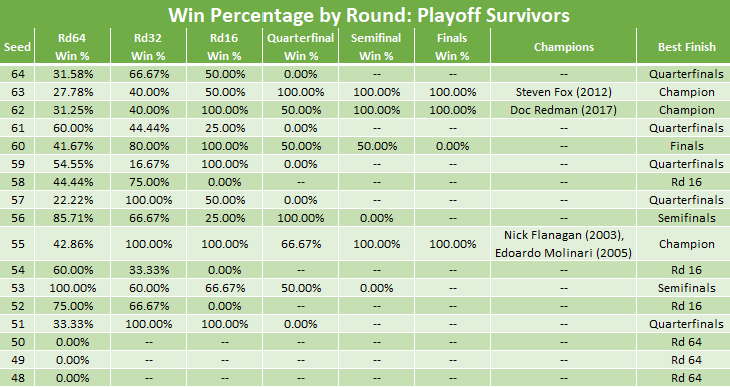
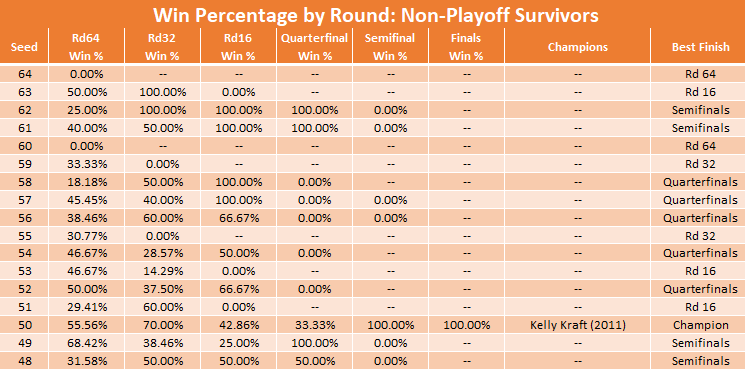
What immediately jumps out when looking at these tables is the number of championships the playoff survivors have won. Not only have they won more championships, they have also had far more seeds with Finals appearances. Moreover, they have had more seeds make semifinal runs, quarterfinal runs, and final 16 runs.
This data further solidifies the notion that as a group, the players who make it through the playoff are able to capitalize on that success with deeper match play runs than similarly seeded players who didn't have to go through the playoff. As an aside, note that the only 64th seeded player to make it to the quarterfinals in the last 20 years was Squires who followed up the grueling playoff with a magical run before losing to 17-year-old Cohen Trolio, the youngest recorded semifinalist in the tournament’s history.
Notable U.S. Amateur playoff participants
A number of recognizable names have appeared in these playoffs over the years. Some notable players who were ultimately unsuccessful include Cole Hammer (2019), Curtis Luck (2014), C.T. Pan (2011), Wyndham Clark (2010), Buddy Marucci (2009), Jordan Spieth (2009), Byeong-Hun An (2008), Rickie Fowler (2007), and Gary Wolstenholme (2004). Two of these – Luck and An – would go on to win championships within two years of failing to advance in their respective playoff.
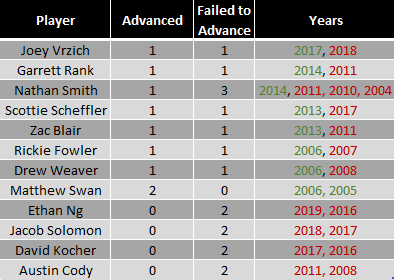
There have been four instances since 2001 where playoff survivors have faced off against each other, a feat that can only occur in the Round of 16 or later.

Incredibly, the 2012 Finals match featured two players to make it through the 17-for-14 playoff. There were only two other occasions – 2005 (19-for-17) and 2003 (14-for-12) – where an all-playoff survivor match-up was nearly realized.
All eyes on...
Aaron Du, Evan Katz and Cameron Sisk.
The three survivors of the 18-for-3 playoff at Bandon Dunes, as would be expected, have difficult first-round matches. Du plays Wilson Furr, the medalist who shot a course-record 62 at Bandon Trails. Katz faces the #2 seed James Piot who shot 69-65 in qualifying, and Sisk plays the #3 seed Ben Shipp who shot 68-67.
But after beating the odds once already, all three players have to feel like they are "playing with house money", and as the data shows, they have a chance to keep the momentum going and perhaps start a deep match play run.
About the US Amateur
The U.S. Amateur, the oldest USGA championship, was first played in 1895 at Newport Golf Club in Rhode Island. The event, which has no age restriction, is open to those with a Handicap Index of .4 (point four) or lower. It is one of 15 national champ...
Most Popular Articles
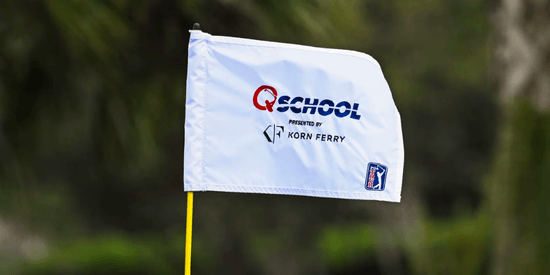
2025 PGA TOUR Q-School Guide: Sites, Scores, and Who Advanced
Dec 5, 2025Second Stage is complete and Final Stage awaits at Sawgrass — follow every Q-School leaderboard and the players still chasing
2025 LPGA TOUR Q-Series: Final Qualifying Stage FINAL SCORING
Dec 8, 2025Helen Briem earns medalist honors, 31 players headed to the LPGA next year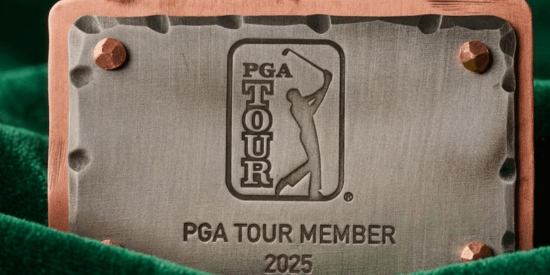
2025 PGA TOUR Q-School Final Stage: Ewart Leads Five New TOUR Card Winners
Dec 14, 2025A.J. Ewart topped Final Stage at TPC Sawgrass, leading five players who secured PGA TOUR membership for 2026.
Australian Open at Royal Melbourne: Preview, amateur bios, and how to watch
Nov 30, 2025Rory McIlroy headlines one of the championship's top fields in years - at least four amateurs will have their chance at gloryInside Gil Hanse’s Restoration of Baltusrol’s Upper Course: A Return to Tillinghast’s
Dec 11, 2025Renowned architect Gil Hanse reveals how he brought Baltusrol’s Upper Course back to life by honoring A.W. Tillinghast’s original